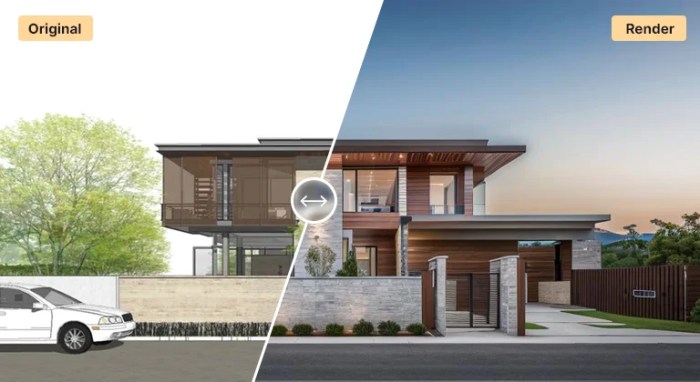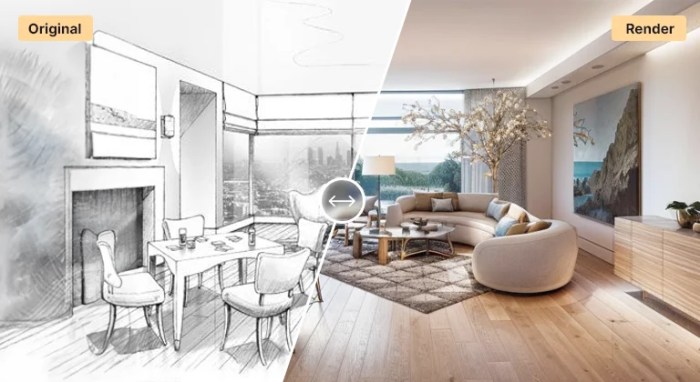Delving into the realm of AI-Enhanced Architectural Rendering Tools opens up a world of innovation and creativity. From revolutionizing traditional methods to enhancing realism, these tools are shaping the future of architectural design.
Overview of AI-Enhanced Architectural Rendering Tools

AI-enhanced architectural rendering tools combine the power of artificial intelligence with traditional rendering techniques to create highly realistic and visually stunning architectural visualizations. These tools utilize AI algorithms to automate and enhance the rendering process, saving time and effort for architects, designers, and developers.
Examples of Popular AI Tools Used in Architectural Rendering
Some popular AI-enhanced architectural rendering tools include:
- NVIDIA Omniverse: NVIDIA's AI-powered platform offers real-time rendering capabilities and collaborative workflows for architectural visualization projects.
- Enscape: This tool uses AI technology to generate interactive 3D renderings that can be explored in real-time, providing a more immersive experience for clients and stakeholders.
- Autodesk Revit: Revit incorporates AI features such as automated design suggestions and rendering optimizations to streamline the architectural design process.
Benefits of Integrating AI into Architectural Rendering Processes
Integrating AI into architectural rendering processes brings several benefits, such as:
- Faster Rendering: AI tools can significantly reduce the time needed to generate high-quality architectural visualizations, allowing for quicker project iterations and decision-making.
- Enhanced Realism: AI algorithms can simulate real-world lighting, textures, and materials more accurately, resulting in highly realistic renderings that closely resemble the final built environment.
- Improved Efficiency: By automating repetitive tasks and optimizing rendering settings, AI-enhanced tools help architects and designers work more efficiently and focus on the creative aspects of their projects.
Advancements in AI Technology for Architectural Rendering

Artificial Intelligence (AI) has brought significant advancements to the architectural rendering industry, revolutionizing the way designs are visualized and presented. Traditional rendering methods have been replaced or enhanced by AI-powered tools, offering more efficient and realistic outcomes.
Comparison between Traditional Rendering Methods and AI-Enhanced Techniques
Traditional rendering methods often required manual input and a time-consuming process to create visual representations of architectural designs. With AI-enhanced techniques, rendering tools can now analyze data, interpret design blueprints, and generate realistic images with minimal human intervention. This results in faster turnaround times and more accurate representations.
Commonly Used AI Algorithms in Architectural Rendering Tools
- Generative Adversarial Networks (GANs): GANs are commonly used in architectural rendering tools to generate high-quality images by training a generator to create images that are indistinguishable from real photographs.
- Convolutional Neural Networks (CNNs): CNNs are utilized for tasks such as image recognition and segmentation in architectural rendering tools. They help in identifying patterns and features within architectural designs to create detailed renderings.
- Recurrent Neural Networks (RNNs): RNNs are employed for sequential data processing in architectural rendering, allowing tools to predict the next steps in rendering processes and optimize the final output.
Key Features of AI-Enhanced Architectural Rendering Tools
AI-enhanced architectural rendering tools offer a range of key features that revolutionize the rendering process, enhancing realism, accuracy, and efficiency.
Enhanced Realism and Accuracy
AI tools utilize advanced algorithms to analyze and interpret architectural designs, resulting in photorealistic renderings that closely mimic real-world environments. By incorporating details such as lighting, textures, and materials, AI-enhanced tools can create visually stunning images that are almost indistinguishable from actual photographs.
Automation of Repetitive Tasks
One of the significant advantages of AI in architectural rendering is its ability to automate repetitive tasks that would typically be time-consuming for designers. AI algorithms can streamline processes such as object placement, material selection, and lighting adjustments, allowing architects to focus more on the creative aspects of their designs.
This automation not only saves time but also ensures consistency and accuracy throughout the rendering process.
Applications and Uses of AI in Architectural Rendering
AI technology has revolutionized the field of architectural rendering, offering a wide range of applications and uses that have transformed the way architects visualize and present their designs. By harnessing the power of artificial intelligence, architects can now create stunning visualizations, improve efficiency, and enhance productivity in architectural firms.
Real-Time Design Modifications
AI tools can analyze and interpret design data in real-time, allowing architects to make instant modifications to their designs. For example, AI algorithms can quickly generate multiple design variations based on specific parameters set by the architect, enabling them to explore different possibilities efficiently
Enhanced Photorealistic Visualizations
With AI-enhanced rendering tools, architects can create highly realistic visualizations that accurately depict lighting, textures, and materials. By leveraging AI algorithms, architectural firms can produce photorealistic images that provide clients with a clear understanding of the final design, even before construction begins.
Automated Image Editing and Post-Production
AI-powered tools can automate the process of image editing and post-production, saving architects valuable time and resources. These tools can enhance images, remove imperfections, adjust lighting, and even generate virtual staging, allowing architects to present their designs in the best possible light.
Virtual Reality and Augmented Reality Experiences
AI technology enables architects to create immersive virtual reality (VR) and augmented reality (AR) experiences for clients. By integrating AI into architectural rendering tools, architects can offer interactive walkthroughs, allowing clients to experience and explore the design in a more engaging and realistic manner.
Optimization of Building Performance
AI algorithms can help architects optimize building performance by analyzing various factors such as energy efficiency, daylighting, and thermal comfort. By simulating different scenarios and evaluating performance metrics, architects can design environmentally sustainable buildings that meet the needs of occupants while reducing energy consumption.
Future Trends and Developments in AI-Enhanced Architectural Rendering
AI technology in architectural rendering is expected to undergo significant advancements in the future, revolutionizing the way design concepts are visualized and presented. As AI continues to evolve, it is crucial to anticipate the potential trends, challenges, and opportunities that may shape the future of architectural rendering.
Predictive Modeling and Simulation
With the progression of AI algorithms and machine learning capabilities, the future of AI-enhanced architectural rendering is likely to focus on predictive modeling and simulation. AI tools will be able to analyze vast amounts of data to generate realistic renderings of architectural designs based on specific parameters and constraints.
This will enable architects and designers to explore various design options quickly and efficiently, ultimately streamlining the design process.
Real-Time Collaboration and Feedback
One of the key challenges in architectural rendering is the need for effective collaboration and feedback mechanisms between stakeholders. In the future, AI-enhanced tools are expected to facilitate real-time collaboration by providing instant feedback on design changes, material selections, and environmental factors.
This seamless integration of AI technology will enhance communication among project teams and lead to more informed decision-making processes.
Environmental Sustainability Integration
As the importance of sustainable design practices continues to grow, AI-enhanced architectural rendering tools are likely to incorporate environmental sustainability metrics into the design process. AI algorithms can analyze factors such as energy efficiency, natural lighting, and material sustainability to optimize building designs for minimal environmental impact.
By integrating sustainability considerations into architectural rendering, AI technology can contribute to the creation of more eco-friendly and efficient buildings.
Augmented Reality and Virtual Reality Integration
The future of AI-enhanced architectural rendering is also expected to include seamless integration with augmented reality (AR) and virtual reality (VR) technologies. Architects and clients will be able to experience architectural designs in immersive virtual environments, allowing for a more interactive and engaging design review process.
AI algorithms will enhance the realism of AR and VR simulations, providing a more accurate representation of the final built environment.
Enhanced Customization and Personalization
With advancements in AI technology, architectural rendering tools are likely to offer enhanced customization and personalization options for clients and end-users. AI algorithms can analyze user preferences and behavior to generate tailored design solutions that meet specific needs and requirements.
This level of customization will result in more personalized architectural designs that reflect the unique preferences of each individual client.
Conclusive Thoughts

In conclusion, AI-Enhanced Architectural Rendering Tools are not just tools; they are game-changers in the architectural industry. Embracing AI opens new possibilities, improves efficiency, and elevates the quality of architectural renderings to unprecedented levels.
Key Questions Answered
How do AI-enhanced tools benefit architectural rendering?
AI tools enhance realism, accuracy, and automate repetitive tasks in the rendering process.
What are some popular AI tools used in architectural rendering?
Popular AI tools include NVIDIA GauGAN, D5 Render, and Lumion.
What are the key features of AI-enhanced architectural rendering tools?
Essential features include enhancing realism, accuracy, and automating repetitive tasks.










